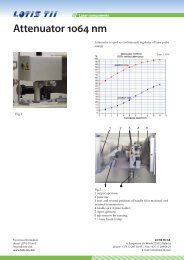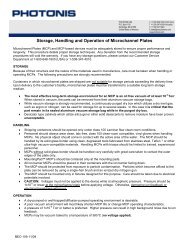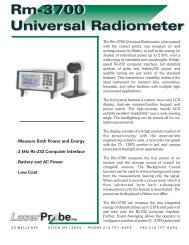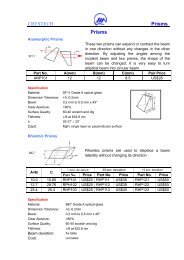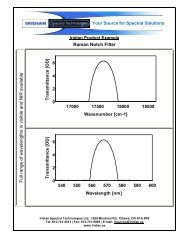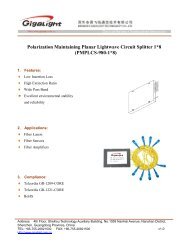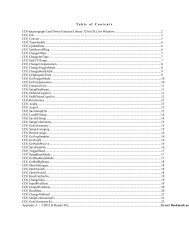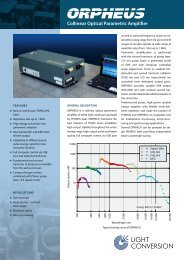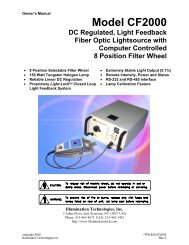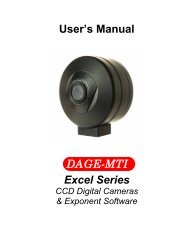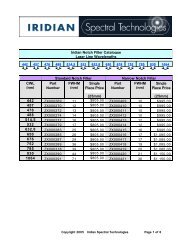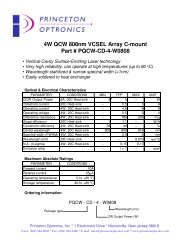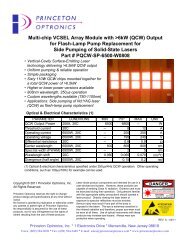Wet Granulation in Rotary Processor and Fluid Bed - ILPhotonics.com
Wet Granulation in Rotary Processor and Fluid Bed - ILPhotonics.com
Wet Granulation in Rotary Processor and Fluid Bed - ILPhotonics.com
- No tags were found...
You also want an ePaper? Increase the reach of your titles
YUMPU automatically turns print PDFs into web optimized ePapers that Google loves.
AAPS PharmSciTech 2006; 7 (1) Article 22 (http://www.aapspharmscitech.org).<strong>Wet</strong> <strong>Granulation</strong> <strong>in</strong> <strong>Rotary</strong> <strong>Processor</strong> <strong>and</strong> <strong>Fluid</strong> <strong>Bed</strong>: Comparison of Granule<strong>and</strong> Tablet PropertiesSubmitted: August 24, 2005; Accepted: January 30, 2006; Published: March 10, 2006Jakob Kristensen 1 <strong>and</strong> Vibeke Wallaert Hansen 11 Department of Pharmaceutics <strong>and</strong> Analytical Chemistry, Danish University of Pharmaceutical Sciences, Copenhagen,DenmarkABSTRACTThe aim of the present study was to <strong>in</strong>vestigate <strong>and</strong> <strong>com</strong>paregranule <strong>and</strong> tablet properties of granules prepared bywet granulation <strong>in</strong> a rotary processor or a conventional fluidbed. For this purpose the work<strong>in</strong>g range of selected processvariables was determ<strong>in</strong>ed <strong>and</strong> a factorial study with 3 factors(equipment type, filler type, <strong>and</strong> liquid addition rate) <strong>and</strong>1 covariate (fluidiz<strong>in</strong>g air flow rate) was performed. Twogrades of calcium carbonate with different size <strong>and</strong> shapecharacteristics were applied, <strong>and</strong> the liquid addition <strong>and</strong>fluidiz<strong>in</strong>g air flow rates were <strong>in</strong>vestigated <strong>in</strong> the widestpossible range. Dry mixtures of microcrystall<strong>in</strong>e cellulose,polyv<strong>in</strong>yl povidone, calcium carbonate, <strong>and</strong> riboflav<strong>in</strong>, <strong>in</strong> a10:5:84:1 ratio, were granulated <strong>in</strong> both types of equipment.The granulation end po<strong>in</strong>t was determ<strong>in</strong>ed manually <strong>in</strong> thefluid bed <strong>and</strong> by torque measurements <strong>in</strong> the rotary processor.The filler type had a more pronounced effect on granularproperties <strong>in</strong> the fluid bed, but the rotary processor showed ahigher dependency on the <strong>in</strong>vestigated process variables. Therotary processor gave rise to more dense granules with betterflow properties, but the fluid bed granules had slightly better<strong>com</strong>pressional properties. Furthermore, the distribution of alow-dose drug was found to be more homogeneous <strong>in</strong> therotary processor granules <strong>and</strong> tablets. Generally, wet granulation<strong>in</strong> a rotary processor was found to be a good alternativeto conventional fluid bed granulation, especially whencohesive powders with poor flow properties or formulationswith low drug content are to be granulated by a fluidiz<strong>in</strong>g airtechnique.KEYWORDS: <strong>Wet</strong> granulation, fluid bed, rotary processorRINTRODUCTION<strong>Wet</strong> granulation is an important process <strong>in</strong> the formulationof solid dosage forms <strong>in</strong> the pharmaceutical <strong>in</strong>dustry. Thema<strong>in</strong> purposes of the granulation procedure are to enhanceCorrespond<strong>in</strong>g Author: Jakob Kristensen, DanishUniversity of Pharmaceutical Sciences, Departmentof Pharmaceutics <strong>and</strong> Analytical Chemistry,2-Universitetsparken, DK-2100 Copenhagen, Denmark.Tel: +(45) 35506000; Fax: +(45) 35306030;E-mail: JK@dfuni.dkthe flow properties of the powder blends <strong>and</strong> to decreasedust problems <strong>in</strong> the h<strong>and</strong>l<strong>in</strong>g of the powder blends. Mostoften, fluid bed or high shear mixer granulation is used forthe wet granulation of pharmaceutical formulations. Analternative to the conventional choice of equipment is theagitation fluid bed, <strong>in</strong> which an impeller is <strong>in</strong>corporated<strong>in</strong>to the bottom of the fluidiz<strong>in</strong>g column. 1 A second, neweralternative for wet granulation of pharmaceutical powdersis the rotary processor. This equipment is also a modifiedversion of a fluid bed <strong>in</strong> which the diameter of the bottomof the fluidiz<strong>in</strong>g column has been <strong>in</strong>creased <strong>and</strong> a rotat<strong>in</strong>gfriction plate has been <strong>in</strong>stalled. The fluidiz<strong>in</strong>g air entersthe fluidiz<strong>in</strong>g chamber through a small gap between therotat<strong>in</strong>g friction plate <strong>and</strong> the wall of the product chamber.Several different names, such as rotary processor, 2 rotaryfluidized bed, 3 rotary fluid bed granulator, 4 rotor fluidizedbed granulator, 5 or fluid bed roto-granulator, 6 have been used<strong>in</strong> the literature. In this article, the term rotary processor isused. Most of the literature regard<strong>in</strong>g wet granulation <strong>in</strong> arotary processor has <strong>in</strong>vestigated the preparation of pelletsby direct wet pelletization, as reviewed by Gu et al. 7 Theeffect of process variables 8,9 <strong>and</strong> formulation variables 10,11on direct pelletization has been <strong>in</strong>vestigated, <strong>and</strong> the processhas been <strong>com</strong>pared with the conventional extrusion spheronizationprocess for the formation of pellets. 12 In most ofthe literature, mixtures of microcrystall<strong>in</strong>e cellulose (MCC)<strong>and</strong> lactose are used as start<strong>in</strong>g materials <strong>and</strong> water is usedas the b<strong>in</strong>der liquid. Generally, direct pelletization <strong>in</strong> a rotaryprocessor has been found to be a sensitive processthat depends on suitable start<strong>in</strong>g materials <strong>and</strong> a high degreeof control over process variables. The water contentat the end of the liquid addition has been found to be themost <strong>in</strong>fluential parameter <strong>in</strong> wet granulation <strong>in</strong> the rotaryprocessor, 2 so a high level of control over this parameter isneeded. One method by which this high level of controlcan be achieved is monitor<strong>in</strong>g the torque of the rotationfriction plate. 8Although the rotary processor has been <strong>com</strong>mercially availablefor several decades, few researchers seem to have publishedstudies of the preparation of granules <strong>in</strong> the rotaryprocessor <strong>and</strong> the <strong>com</strong>pression of these granules <strong>in</strong>to tablets.Jäger <strong>and</strong> Bauer <strong>in</strong>vestigated <strong>and</strong> <strong>com</strong>pared granulation<strong>in</strong> a rotary processor <strong>and</strong> a conventional fluid bedus<strong>in</strong>g the same formulation <strong>and</strong> process variables <strong>in</strong> bothE1
Table 1. Characterization of Start<strong>in</strong>g Materials*AAPS PharmSciTech 2006; 7 (1) Article 22 (http://www.aapspharmscitech.org).Particle Size Surface AreaPycnometricDensity Poured Bulk DensityTappedBulk Density Carr IndexExcipient(μm) (m 2 /g) (g/mL) (g/mL) (g/mL) (%)Sturcal (CaCo 3 ) 9 (0.5) 2.90 ± 0.17 2.63 (0.01) 0.59 ± 0.00 0.88 ± 0.01 32.9 ± 0.9Scoralit (CaCo 3 ) 29 (2) 0.49 ± 0.00 2.71 (0.01) 1.31 ± 0.01 1.69 ± 0.00 22.2 ± 0.5MCC 123 (4) — 1.57 (0.01) 0.38 ± 0.00 0.46 ± 0.00 17.0 ± 0.7PVP 118 (2) — 1.16 (0.05) 0.36 ± 0.00 0.43 ± 0.00 17.5 ± 0.6*MCC <strong>in</strong>dicates microcrystall<strong>in</strong>e cellulose; PVP, polyv<strong>in</strong>yl povidone.types of equipment. 4 They found that the very homogeneousropelike movement of the powder bed <strong>in</strong> the rotaryprocessor allows for considerably higher spray<strong>in</strong>g ratesthan <strong>in</strong> a traditional fluid bed granulator, <strong>in</strong> spite of a lowerair flow rate. 4 They expla<strong>in</strong>ed that this resulted from themore <strong>in</strong>tense <strong>and</strong> uniform material motion <strong>in</strong> the rotaryprocessor, caused by the unique cooperation between thecentrifugal forces, gravity, <strong>and</strong> the fluidiz<strong>in</strong>g air. Comparedwith granules from conventional fluid bed granulators,spherical granules from a rotary processor possess higherapparent densities, higher tapped <strong>and</strong> bulk densities, <strong>and</strong>lower porosities. 4 In another study, 3 the rotary processorwas found to produce a better drug content uniformity fortablets, <strong>com</strong>pared with literature f<strong>in</strong>d<strong>in</strong>gs from conventionalfluid bed granules. This was found to be the caseeven at low active levels such as 1%. 3The aim of the current study was to directly <strong>com</strong>pare rotaryprocessor <strong>and</strong> fluid bed granulation <strong>in</strong> laboratory scaleequipment <strong>and</strong> to <strong>in</strong>vestigate the effect of formulation <strong>and</strong>process variables on granule <strong>and</strong> tablet properties.MATERIALS AND METHODSMaterialsMCC (Avicel, type PH102, FMC International, Cork, Irel<strong>and</strong>),calcium carbonate (Scoralit, Scora SA, Caffiers, France; <strong>and</strong>Sturcal L, Specialty M<strong>in</strong>erals, Lifford, UK), <strong>and</strong> polyv<strong>in</strong>ylpovidone (Povidone) (PVP K-30, BASF, Ludwigshafen,Germany) were used as start<strong>in</strong>g materials. All materialswere of European Pharmacopoeia grade, as stated by thesuppliers. The determ<strong>in</strong>ed physical properties of the start<strong>in</strong>gmaterials are shown <strong>in</strong> Table 1. Purified water was usedas the granulation liquid. The droplet size characteristicsof the atomized granulation liquid are shown <strong>in</strong> Table 2.Riboflav<strong>in</strong> (BASF) was used as the marker <strong>com</strong>pound.Experimental DesignA factorial designed study with 3 categorical <strong>in</strong>dependentvariables (factors) <strong>and</strong> one cont<strong>in</strong>uous predictor variable(covariate) was performed. The 3 factors were <strong>in</strong>vestigatedat 2 levels <strong>and</strong> the covariate was <strong>in</strong>vestigated at 2 levelsfor each of the <strong>com</strong>b<strong>in</strong>ations of the <strong>in</strong>dependent variables.Each experiment was performed <strong>in</strong> duplicate, giv<strong>in</strong>g a totalof 32 granulation experiments. The <strong>in</strong>cluded factors werethe type of granulation equipment, the filler type (grade ofcalcium carbonate), <strong>and</strong> the liquid addition rate; <strong>and</strong> thecovariate was the fluidiz<strong>in</strong>g air flow rate. The <strong>com</strong>positionof the applied formulations is shown <strong>in</strong> Table 3, <strong>and</strong>the experimental setup is shown <strong>in</strong> Table 4. PVP was usedas a dry b<strong>in</strong>der, <strong>and</strong> water was used as a b<strong>in</strong>der liquid toallow for torque-controlled end po<strong>in</strong>t determ<strong>in</strong>ation <strong>in</strong> therotary processor without changes <strong>in</strong> the <strong>com</strong>position of theprepared agglomerates.The <strong>in</strong>cluded response variables were loss of material (LOM),amount of oversized granules, granular bulk density <strong>and</strong>porosity, granular size <strong>and</strong> size distribution, granular flowproperties (Carr <strong>in</strong>dex <strong>and</strong> tablet mass deviation), tabletcrush<strong>in</strong>g strength, tablet porosity, <strong>and</strong> tablet dis<strong>in</strong>tegrationtime. In addition, the distribution of drug marker <strong>in</strong> differentsize fractions was <strong>in</strong>vestigated.The results were subjected to statistical analysis of covarianceus<strong>in</strong>g the general l<strong>in</strong>ear models module <strong>in</strong> STATISTICA(Statistica, Version 7.0, StatSoft Inc, Tulsa, OK) to analyze theTable 2. Droplet Size Determ<strong>in</strong>ationsNozzle Type Liquid Flow Rate Mean Droplet Size (d 0.5 ) μm (n = 2) Span* (n = 2)<strong>Rotary</strong> processor<strong>Fluid</strong> bed*(d 0.9 -d 0.1 )/d 0.5Low (30 g/m<strong>in</strong>) 19.8 ± 0.1 1.60 ± 0.06High (55 g/m<strong>in</strong>) 21.7 ± 0.1 2.74 ± 0.01Low (30 g/m<strong>in</strong>) 25.6 ± 0.2 1.29 ± 0.01High (55 g/m<strong>in</strong>) 27.3 ± 0.2 1.40 ± 0.04E2
AAPS PharmSciTech 2006; 7 (1) Article 22 (http://www.aapspharmscitech.org).Table 3. Composition of the Investigated Formulations*Formulation: Blend AFormulation: Blend BMaterial Fraction (%) Amount (g) Material Fraction (%) Amount (g)Avicel PH102 10 82.5 Avicel PH102 10 82.5Povidone K-30 5 41.25 Povidone K-30 5 41.25Sturcal L 84 693 Scoralit 84 693Riboflav<strong>in</strong> 1 8.25 Riboflav<strong>in</strong> 1 8.25*Total batch size: 825 g.effect of the categorical <strong>in</strong>dependent variables (factors), controll<strong>in</strong>gfor the effects of the cont<strong>in</strong>uous predictor variable.Effects with a P value below .05 were denoted significant.<strong>Fluid</strong> <strong>Bed</strong> <strong>Granulation</strong>A Glatt GPCG-1 (Glatt GPCG-1.1; Glatt, B<strong>in</strong>zen, Germany)mounted with the fluid bed column was used. The start<strong>in</strong>gmaterials (825 g) were mixed manually (preblend), sievedthrough a 0.5-mm sieve, <strong>and</strong> loaded <strong>in</strong>to the equipment,which had been preconditioned for approximately 10 m<strong>in</strong>utes.The <strong>in</strong>let air temperature was set to 25°C, <strong>and</strong> thefluidiz<strong>in</strong>g air flow was set accord<strong>in</strong>g to the experimentalsetup, listed <strong>in</strong> Table 4. The granulation liquid was sprayedonto the fluidized powder bed us<strong>in</strong>g a pneumatic atomizerat a 1.0-bar atomiz<strong>in</strong>g air pressure. The fluid bed nozzle(Schlick 970/0-S3, Düsen-Schlick GmbH, Coburg, Germany),equipped with a 1.0-mm tip orifice <strong>and</strong> a 6.5-mmair dome spacer r<strong>in</strong>g, was placed <strong>in</strong> the lower nozzle <strong>in</strong>let,which was approximately 15 cm above the rest<strong>in</strong>g powderbed. The liquid addition rate was set accord<strong>in</strong>g to the experimentalsetup. The liquid addition was term<strong>in</strong>ated oncethe agglomerates had reached a suitable size, judged visuallyby the operator. After the liquid addition, the granuleswere dried <strong>in</strong> the equipment by <strong>in</strong>creas<strong>in</strong>g the fluidiz<strong>in</strong>g airflow rate by 80% until the product temperature had risen toroom temperature. The dried granules were placed <strong>in</strong> openconta<strong>in</strong>ers <strong>and</strong> stored at room temperature.<strong>Rotary</strong> <strong>Processor</strong> <strong>Granulation</strong>A Glatt GPCG-1 (Glatt GPCG-1.1) mounted with the rotaryprocessor <strong>in</strong>set, which was equipped with a cross-hatchedfriction plate, was used. The start<strong>in</strong>g materials (825 g) weremixed manually (preblend), sieved through a 0.5-mm sieve,<strong>and</strong> loaded <strong>in</strong>to the equipment, which had been preconditionedfor approximately 10 m<strong>in</strong>utes. The <strong>in</strong>let air temperaturewas set to 25°C, <strong>and</strong> the fluidiz<strong>in</strong>g air flow wasset accord<strong>in</strong>g to the experimental setup, listed <strong>in</strong> Table 4. Theair gap pressure difference was set to 2.0 kPa by elevat<strong>in</strong>gTable 4. Experimental Setup for the 3 Categorical Independent Variables <strong>and</strong> the Cont<strong>in</strong>uous Predictor Variable*Categorical Independent VariablesCont<strong>in</strong>uous Predictor VariableBatch Equipment Calcium Grade B<strong>in</strong>der Addition Rate† <strong>Fluid</strong>iz<strong>in</strong>g Air Flow‡1a-b RP (–1) Sturcal (–1) Low (–1) Low (40)2a-b RP (–1) Sturcal (–1) Low (–1) High (50)3a-b RP (–1) Sturcal (–1) High (1) Low (45)4a-b RP (–1) Sturcal (–1) High (1) High (60)5a-b RP (–1) Scoralit (1) Low (–1) Low (35)6a-b RP (–1) Scoralit (1) Low (–1) High (45)7a-b RP (–1) Scoralit (1) High (1) Low (40)8a-b RP (–1) Scoralit (1) High (1) High (60)9a-b FB (1) Sturcal (–1) Low (–1) Low (60)10a-b FB (1) Sturcal (–1) Low (–1) High (70)11a-b FB (1) Sturcal (–1) High (1) Low (60)12a-b FB (1) Sturcal (–1) High (1) High (90)13a-b FB (1) Scoralit (1) Low (–1) Low (30)14a-b FB (1) Scoralit (1) Low (–1) High (40)15a-b FB (1) Scoralit (1) High (1) Low (35)16a-b FB (1) Scoralit (1) High (1) High (60)*Values <strong>in</strong> parentheses were used <strong>in</strong> the statistical analysis. RP <strong>in</strong>dicates rotary processor; FB, fluid bed.†Low: 30 g/m<strong>in</strong>; high: 55 g/m<strong>in</strong>.‡Flow <strong>in</strong> m 3 /h.E3
AAPS PharmSciTech 2006; 7 (1) Article 22 (http://www.aapspharmscitech.org).the friction plate, <strong>and</strong> the rotation of the friction plate wasstarted at 900 rpm. The granulation liquid was then sprayedtangentially <strong>in</strong>to the mov<strong>in</strong>g powder us<strong>in</strong>g a pneumaticatomizer at a 1.0-bar atomiz<strong>in</strong>g air pressure. The liquidaddition rate was set accord<strong>in</strong>g to the experimental setup.The rotary processor nozzle (Schlick 970/0-S3, Düsen-Schlick GmbH) was equipped with a 1.0-mm tip orifice <strong>and</strong>a 3-mm air dome spacer r<strong>in</strong>g. The granulation end po<strong>in</strong>t wasdeterm<strong>in</strong>ed by torque measurements, <strong>and</strong> the water additionwas term<strong>in</strong>ated when a 0.15-Nm <strong>in</strong>crease <strong>in</strong> the torque ofthe friction plate was reached. The torque <strong>in</strong>crease was<strong>com</strong>puted as the difference between the current torque value<strong>and</strong> the m<strong>in</strong>imum torque value, as described elsewhere. 8After the liquid addition, the granules were dried <strong>in</strong> theequipment by <strong>in</strong>creas<strong>in</strong>g the fluidiz<strong>in</strong>g air flow rate by80% until the product temperature had risen to room temperature.After dry<strong>in</strong>g, the prepared agglomerates werestored <strong>in</strong> open conta<strong>in</strong>ers at room temperature.Tablet ManufactureThe granules were <strong>com</strong>pressed, without lubrication, <strong>in</strong>to600-mg tablets us<strong>in</strong>g a s<strong>in</strong>gle-punch tablet mach<strong>in</strong>e (FetteExcata 1/F, Fette GmbH, Schwarzenbek, Germany). Thetablet mach<strong>in</strong>e was equipped with an 11.3-mm (1 cm 2 ) flatfacedpunch <strong>and</strong> set to run at 60 <strong>com</strong>pressions per m<strong>in</strong>utewith a 100-MPa (10 kN per cm 2 ) <strong>com</strong>pressional pressure.The <strong>com</strong>pression force was measured on the lower punch<strong>and</strong> set by adjust<strong>in</strong>g the downward movement of the upperpunch. The prepared tablets were characterized accord<strong>in</strong>g touniformity of mass (relative SD), specific crush<strong>in</strong>g strength(SCS), tablet porosity, <strong>and</strong> dis<strong>in</strong>tegration time.Determ<strong>in</strong>ation of Droplet SizeThe droplet size <strong>and</strong> size distribution (span) were determ<strong>in</strong>ed<strong>in</strong> duplicate for both the rotary processor <strong>and</strong> thefluid bed nozzles us<strong>in</strong>g a Malvern 2600 C Particle Sizer(Malvern Instruments Ltd., Malvern, Worchestershire, UK)equipped with a 100-mm lens. The determ<strong>in</strong>ations wereperformed as described above. 13Characterization of Start<strong>in</strong>g Materials <strong>and</strong> GranulesThe size distribution by volume of the start<strong>in</strong>g materials wasdeterm<strong>in</strong>ed <strong>in</strong> triplicate by a Malvern 2601Lc laser diffractionparticle sizer (Malvern Instruments), <strong>and</strong> the medianparticle diameter <strong>and</strong> range of repeated experiments werereported.The pycnometric density of the start<strong>in</strong>g materials was determ<strong>in</strong>edby an AccuPyc 1330 gas displacement pycnometer(Micromeritics, Norcross, GA) us<strong>in</strong>g a helium purge (n = 6).The poured (p o ) <strong>and</strong> tapped bulk densities (p k ) of the start<strong>in</strong>gmaterials, preblends, <strong>and</strong> granules were determ<strong>in</strong>ed <strong>in</strong>duplicate us<strong>in</strong>g the test for apparent volume as described <strong>in</strong>the European Pharmacopoeia 4th edition, <strong>and</strong> the Carr<strong>in</strong>dex (K) was calculated accord<strong>in</strong>g to Equation 1:K ¼pk−p0 • 100%pkð1ÞThe granular porosity (ε), <strong>in</strong>clud<strong>in</strong>g <strong>in</strong>ter- <strong>and</strong> <strong>in</strong>tragranularvoids, was calculated accord<strong>in</strong>g to Equation 2:ε ¼ 1 − pk; ð2Þpwhere p is the pycnometric density of the applied preblendof the start<strong>in</strong>g materials (g/mL).The surface area of the calcium carbonates was determ<strong>in</strong>ed<strong>in</strong> duplicate by the Brunauer-Emmett-Teller (BET) multipo<strong>in</strong>tmethod (Gem<strong>in</strong>i 2375 Surface Area Analyzer, Micromeritics.)The LOM due to adhesion <strong>and</strong> filter penetration was determ<strong>in</strong>edas the difference <strong>in</strong> mass between the start<strong>in</strong>g materials<strong>and</strong> the granules relative to the mass of the start<strong>in</strong>gmaterials. The amount of the oversized granules (92800 µm)was determ<strong>in</strong>ed relative to the mass of the start<strong>in</strong>g materials.The size distribution of the granule fraction that had passedthrough a 2800-μm sieve was estimated by sieve analysisof a sample of ~80 g drawn from the entire batchus<strong>in</strong>g a Laborette 27 automatic rotary cone sample divider(Fritsch, Idar-Oberste<strong>in</strong>, Germany). A series of 9 ASTMst<strong>and</strong>ard sieves (Retsch, Haan, Germany) <strong>in</strong> the range of 75to 2000 μm were vibrated for 10 m<strong>in</strong>utes by a Fritsch analysette3 vibrator (Fritsch) us<strong>in</strong>g a 3.5-mm amplitude. Thegranule size distributions were <strong>in</strong> good agreement with thelog-normal distribution. Consequently, the mean granulesize was described by the geometric weight mean diameter(d gw ) <strong>and</strong> the size distribution by the geometric SD (s g ).Granules from selected experiments were <strong>in</strong>vestigated us<strong>in</strong>ga scann<strong>in</strong>g electron microscope (SEM) (JSM 5200, Jeol,Tokyo, Japan).The content of riboflav<strong>in</strong> was determ<strong>in</strong>ed by UV measurement.Granule samples of approximately 0.15 g were dispersed<strong>in</strong> water <strong>and</strong> filtered, <strong>and</strong> the UV absorbance wasmeasured at 444 nm (UV spectrometer UV-160A, Shimadzu,Kyoto, Japan). The content was determ<strong>in</strong>ed <strong>in</strong>3 fractions: f<strong>in</strong>es (smaller than 125 μm), medium granules(between 125 μm <strong>and</strong> 355 μm) <strong>and</strong> large granules (largerthan 355 μm).E4
AAPS PharmSciTech 2006; 7 (1) Article 22 (http://www.aapspharmscitech.org).Figure 1. Scann<strong>in</strong>g electron microscope pictures of the applied calcium carbonate grades Sturcal (Blend A) <strong>and</strong> Scoralit (Blend B).Magnification ×500.Characterization of TabletsSCS of the tablets was determ<strong>in</strong>ed as the crush<strong>in</strong>g strengthdivided by the cross-sectional area of the tablets. SCS foreach batch was calculated as an average of 20 r<strong>and</strong>omlydrawn tablets. The crush<strong>in</strong>g strength of the tablets wasdeterm<strong>in</strong>ed by a st<strong>and</strong>ard tablet hardness tester (Schleuniger8M tablet hardness tester, Schleuniger, Horgen, Switzerl<strong>and</strong>).The tablet height, applied to calculate the crosssectionalarea <strong>and</strong> the tablet volume, was determ<strong>in</strong>edus<strong>in</strong>g a digital height-measur<strong>in</strong>g device (Digital Indicator,type IDF-130, Mitutoyo Corporation, Kawasaki, Japan).The tablet porosity was calculated accord<strong>in</strong>g to Equation 3:0εtablet ¼ 1 −@m tabletpv tablet1Að3Þwhere m tablet is the tablet mass (g), p is the pycnometricdensity of the applied preblend of the start<strong>in</strong>g materials(g/mL), <strong>and</strong> v tablet is the tablet volume (mL).RESULTS AND DISCUSSIONTwo different grades of calcium carbonate were chosen asmodel fillers. The physical properties of the start<strong>in</strong>g materialsare shown <strong>in</strong> Table 1, <strong>and</strong> the particle shapes of theapplied calcium carbonate grades are shown <strong>in</strong> Figure 1.Because of the small particle size <strong>and</strong> irregular surfacestructure of Sturcal L, Blend A can be characterized as cohesive,whereas Blend B is more free-flow<strong>in</strong>g because of thelarger particle size <strong>and</strong> regular particle shape of Scoralit.A series of prelim<strong>in</strong>ary experiments were performed toestablish the lowest <strong>and</strong> highest rates of liquid addition <strong>and</strong>fluidiz<strong>in</strong>g air flow that would result <strong>in</strong> a successful granulationwith both types of equipment <strong>and</strong> formulations. Thecriteria for a successful granulation were visible agglomerategrowth with<strong>in</strong> 20 m<strong>in</strong>utes of liquid addition <strong>and</strong>low amounts of adhesion <strong>and</strong> oversized granules, as wellas a good movement or fluidization of the powder blendthroughout the process. Figure 2 shows the work<strong>in</strong>g areasas they appear when the determ<strong>in</strong>ed boundary po<strong>in</strong>ts areThe tablet uniformity of mass was determ<strong>in</strong>ed as therelative SD of 20 r<strong>and</strong>omly drawn tablets.The tablet dis<strong>in</strong>tegration time, an average of the dis<strong>in</strong>tegrationtimes of 6 r<strong>and</strong>omly drawn tablets, was determ<strong>in</strong>ed bythe st<strong>and</strong>ard European Pharmacopeia 14 method <strong>in</strong> 37°Cdem<strong>in</strong>eralized water. The tablet friability was determ<strong>in</strong>ed bythe st<strong>and</strong>ard European Pharmacopeia 14 method us<strong>in</strong>g 10 r<strong>and</strong>omlydrawn tablets.Images of the tablets were made with a digital camera(Inf<strong>in</strong>ity X, DeltaPix, Maalov, Denmark) equipped with a60-mm lens (60mm f/2.8D AF Micro-Nikkor, Nikon,Tokyo, Japan).Figure 2. The determ<strong>in</strong>ed work<strong>in</strong>g ranges of the RP <strong>and</strong> the FB.RP <strong>in</strong>dicates rotary processor; FB, fluid bed.E5
AAPS PharmSciTech 2006; 7 (1) Article 22 (http://www.aapspharmscitech.org).Table 5. Result<strong>in</strong>g P <strong>and</strong> R 2 Values From the Statistical Analysis for the Investigated Process <strong>and</strong> Granule Response Variables*LOM Bulk Density Granular Porosity† Carr Index Relative SD Mass‡ d( gw ) ∫ s( g ) ║Variable R 2 0.746 R 2 0.960 R 2 0.965 R 2 0.774 R 2 0.734 R 2 0.663 R 2 0.753Air flow 0.757 0.075 0.150 0.196 0.344 0.034 0.078(A) Equipment 0.000 0.000 0.000 0.000 0.062 0.002 0.002(B) Filler type 0.099 0.000 0.000 0.125 0.858 0.991 0.000(C) Addition rate 0.114 0.008 0.004 0.512 0.863 0.111 0.166A * B 0.132 0.009 0.051 0.007 0.023 0.008 0.749A*C 0.016 0.003 0.010 0.077 0.071 0.010 0.388B * C 0.917 0.356 0.794 0.141 0.548 0.077 0.761A * B * C 0.963 0.426 0.453 0.696 0.650 0.119 0.186*Bold values <strong>in</strong>dicate significant effect (P G .05). LOM <strong>in</strong>dicates loss of mass dur<strong>in</strong>g granulation.†Porosity <strong>in</strong>clud<strong>in</strong>g <strong>in</strong>ter- <strong>and</strong> <strong>in</strong>tragranular voids.‡Relative SD of tablet mass (n = 20).∫Mean diameter.║Size distribution.connected. The application of sett<strong>in</strong>gs outside of the determ<strong>in</strong>edwork<strong>in</strong>g areas will give rise to problems such asblock<strong>in</strong>g of the bag filters, <strong>in</strong>sufficient fluidization of thepowder bed, lengthy process times, adhesion, <strong>and</strong> snowballformation. The values of liquid addition <strong>and</strong> fluidiz<strong>in</strong>g airflow rate used <strong>in</strong> the factorial designed study were chosento give the widest possible range with a m<strong>in</strong>imal differenceof 10 m 3 /h between the high <strong>and</strong> low levels of fluidiz<strong>in</strong>gair flow. The determ<strong>in</strong>ed work<strong>in</strong>g ranges are valid foronly the applied process <strong>and</strong> formulation variables, <strong>and</strong>changes <strong>in</strong> parameters like batch size or <strong>in</strong>let air temperaturewill shift the work<strong>in</strong>g range batch size. The similarwork<strong>in</strong>g range of liquid addition rate for the 2 types ofequipment (approximately 10-55 g/m<strong>in</strong>), seen <strong>in</strong> Figure 2,contradicts previous suggestions that the <strong>in</strong>creased agitationof the powder bed <strong>in</strong> the rotary processor would allowfor higher liquid addition rates. 4 These f<strong>in</strong>d<strong>in</strong>gs were notbased on laboratory scale equipment, which might expla<strong>in</strong>the difference. For each <strong>com</strong>b<strong>in</strong>ation of equipment, fillertype, <strong>and</strong> liquid addition rate, a different range of fluidiz<strong>in</strong>gair flow rates was found, as shown <strong>in</strong> Figure 2. Blend Arequired a higher fluidiz<strong>in</strong>g air flow rate than Blend B forsuccessful fluidization <strong>in</strong> the fluid bed. This could be expecteds<strong>in</strong>ce Blend A conta<strong>in</strong>s the small, irregularly shapedcalcium carbonate grade, whose cohesive nature can beseen <strong>in</strong> the high Carr <strong>in</strong>dex <strong>and</strong> low bulk density, as listed<strong>in</strong> Table 1. The fact that only a small difference <strong>in</strong> the work<strong>in</strong>grange was found for the rotary processor could suggestthat granulation <strong>in</strong> the rotary processor is less sensitive tothe flow properties of the powder bed than is conventionalfluid bed granulation, <strong>and</strong> that the rotary processor might beable to successfully granulate powder blends that are toocohesive for fluid bed granulation.Two different nozzles <strong>and</strong> 2 different liquid addition rateswere applied <strong>in</strong> the present <strong>in</strong>vestigation. Only a m<strong>in</strong>or difference<strong>in</strong> the droplet size was found, as listed <strong>in</strong> Table 2.Possible effects on the <strong>in</strong>vestigated response variables dueto differences <strong>in</strong> droplet size could therefore be disregarded.The amount of b<strong>in</strong>der liquid needed for agglomerate growthto occur ranged from 100 to 500 g with a maximum differencebetween repeated experiments of approximately30 g. This shows the necessity of us<strong>in</strong>g the torque or visualend po<strong>in</strong>t determ<strong>in</strong>ation method <strong>and</strong> not add<strong>in</strong>g a certa<strong>in</strong>amount of b<strong>in</strong>der liquid. Generally only a small effect ofliquid addition rate <strong>and</strong> fluidiz<strong>in</strong>g air flow rate was seen <strong>in</strong>both types of equipment. An effect of the applied blend wasseen <strong>in</strong> both types of equipment, with Blend A need<strong>in</strong>gapproximately 300 g <strong>in</strong> the rotary processor <strong>and</strong> approximately500 g <strong>in</strong> the fluid bed, whereas Blend B neededapproximately 150 g <strong>in</strong> the rotary processor <strong>and</strong> approximately100 g <strong>in</strong> the fluid bed.High yields are important, especially from an <strong>in</strong>dustrialperspective. LOM due to either adhesion to the equipmentwalls or filter penetration dur<strong>in</strong>g the granulation procedureis nevertheless <strong>in</strong>evitable. The average LOM was 8% <strong>in</strong> thefluid bed <strong>and</strong> 20% <strong>in</strong> the rotary processor. Statistically significanteffects were found for the equipment type as wellas for the <strong>in</strong>teraction between equipment type <strong>and</strong> liquidaddition rate, as listed <strong>in</strong> Table 5. The high LOM <strong>in</strong> therotary processor is caused by material adher<strong>in</strong>g to the rotat<strong>in</strong>gfriction plate. In the present experiments a plate witha cross-hatched pattern was used. Application of a smoothplate might reduce the high LOM found <strong>in</strong> the rotaryprocessor. Higher liquid addition rates gave rise to higherLOM <strong>in</strong> the rotary processor but not <strong>in</strong> the fluid bed, whichexpla<strong>in</strong>s the significant <strong>in</strong>teraction between equipment type<strong>and</strong> liquid addition rate, listed <strong>in</strong> Table 5. High amounts(15%) of oversized granules were found <strong>in</strong> the rotaryprocessor for batches prepared from Blend B at high liquidaddition rates <strong>and</strong> high air flow rates (batches 8a <strong>and</strong> 8b).All other experiments produced no or less than 1% oversizedgranules <strong>and</strong>, because of the lack of response, no statisticalE6
AAPS PharmSciTech 2006; 7 (1) Article 22 (http://www.aapspharmscitech.org).analysis was performed. The experiments that gave rise tohigh amounts of oversized granules also resulted <strong>in</strong> a largemean granule size. Figure 3 shows the effect of the <strong>in</strong>vestigatedvariables on granule size <strong>and</strong> size distribution.Because of the large amount of oversized granules <strong>and</strong> thelarge granule size found with batch 8, the applied torque<strong>in</strong>crease, used to determ<strong>in</strong>e the end po<strong>in</strong>t of liquid addition,was not optimal for this batch. Generally, good reproducibilityof the granule size was achieved for the repeatedexperiments. Only a small effect of the <strong>in</strong>vestigated variablescan be seen <strong>in</strong> the fluid bed, where the mean diameterranges from 215 to 295 µm. The lack of effect could beexpected s<strong>in</strong>ce the granulation process was term<strong>in</strong>atedwhen a certa<strong>in</strong> size was achieved, judged visually by theoperator. In the rotary processor, where the end po<strong>in</strong>t wascontrolled by torque measurements, the granule size rangedfrom 200 to 850 µm. The good reproducibility betweenrepeated experiments <strong>in</strong>dicates that torque measurementscan be used to determ<strong>in</strong>e the end po<strong>in</strong>t <strong>in</strong> rotary processorgranulation. The statistical analysis gave rise to significanteffects, as shown <strong>in</strong> Table 5. They are difficult to <strong>in</strong>terpretbecause of the different methods by which the size wascontrolled <strong>in</strong> the 2 equipment types. It is clear that a widerFigure 3. Effects of the <strong>in</strong>vestigated variables on granule size<strong>and</strong> granule size distribution. RP <strong>in</strong>dicates rotary processor; FB,fluid bed; L, low; H, high. Error bars <strong>in</strong>dicate the range ofrepeated experiments.size range of granules is obta<strong>in</strong>able <strong>in</strong> the rotary processorthan <strong>in</strong> the fluid bed. This is an advantage, especially if thegranules are <strong>in</strong>tended for further process<strong>in</strong>g, such as entericcoat<strong>in</strong>g or taste mask<strong>in</strong>g. The size distribution of the preparedgranules, shown <strong>in</strong> Figure 3, also showed goodreproducibility. Significant effects were found for equipment<strong>and</strong> filler type, with the rotary processor giv<strong>in</strong>g riseto lower s g values, <strong>and</strong> thus a more narrow size distribution.Blend A, which used the more cohesive filler type,gave rise to wider particle size distributions for both typesof equipment. A lower amount of f<strong>in</strong>es <strong>in</strong> the granules fromthe rotary processor might expla<strong>in</strong> the more narrow sizedistribution obta<strong>in</strong>ed with this equipment. The loweramount of f<strong>in</strong>es <strong>in</strong> the rotary processor might be expla<strong>in</strong>edby a higher amount <strong>and</strong> a more homogeneous distributionof liquid at the surface of the granules, which would promotethe coalescence between f<strong>in</strong>es <strong>and</strong> granules. It mighthave been expected that higher amounts of f<strong>in</strong>es would beseen <strong>in</strong> the rotary processor because of attrition dur<strong>in</strong>gdry<strong>in</strong>g due to the contact between granules <strong>and</strong> the rotat<strong>in</strong>gfriction plate. The fact that no <strong>in</strong>creased attrition was seen <strong>in</strong>the rotary processor might be expla<strong>in</strong>ed by the adhesion ofmaterial to the friction plate, which would reduce the frictionbetween the plate <strong>and</strong> the granules.A great effect of the <strong>in</strong>creased agitation of the powderbed <strong>in</strong> the rotary processor is seen <strong>in</strong> the determ<strong>in</strong>ed bulkdensities. The average bulk density of the rotary processorbatches was approximately 0.9 g/mL <strong>com</strong>pared with0.6 g/mL <strong>in</strong> the fluid bed. This corresponds to a 30% decrease<strong>in</strong> volume when chang<strong>in</strong>g from the fluid bed to therotary processor. The statistical analysis gave rise to severalsignificant effects, as listed <strong>in</strong> Table 5. Blend B gaverise to higher bulk densities than Blend A, which couldbe expected because of the higher bulk density of filler(Scoralit), listed <strong>in</strong> Table 1, <strong>in</strong> this blend. A higher liquidaddition rate was also found to <strong>in</strong>crease the bulk density.This effect was most pronounced <strong>in</strong> the rotary processor,which expla<strong>in</strong>s the significant <strong>in</strong>teraction found betweenequipment <strong>and</strong> liquid addition rate. The granular porositywas significantly lower <strong>in</strong> the rotary processor because ofthe <strong>in</strong>creased agitation. An average of 60% was found <strong>in</strong>the rotary processor <strong>and</strong> 70% <strong>in</strong> the fluid bed. Filler type<strong>and</strong> liquid addition rate also gave rise to significant effects,as listed <strong>in</strong> Table 5. Based on the SEM pictures, it might beexpected that Blend A would give rise to lower porositiesthan Blend B. However, because of the irregular particleshape of the filler <strong>in</strong> Blend A, Blend B gave rise to porositiesthat were statistically significantly lower than thoseof Blend A.The granular flow properties are another important parameter<strong>in</strong> an <strong>in</strong>dustrial perspective. They are <strong>in</strong>fluenced byparameters such as granular density, shape, <strong>and</strong> surfacestructure. The Carr <strong>in</strong>dex is often applied to quantify theE7
AAPS PharmSciTech 2006; 7 (1) Article 22 (http://www.aapspharmscitech.org).flow properties. Lower Carr <strong>in</strong>dex values <strong>in</strong>dicate betterflow properties. The statistical analysis revealed a significanteffect of equipment type as well as a significant <strong>in</strong>teractionbetween equipment <strong>and</strong> filler type, as listed <strong>in</strong>Table 5. The rotary processor gave rise to values around10%, whereas the fluid bed gave rise to values around 15%.No effect of filler type was seen <strong>in</strong> the rotary processor, butBlend B gave rise to significantly higher values <strong>in</strong> the fluidbed. This expla<strong>in</strong>s the significant <strong>in</strong>teraction found betweenthese 2 factors. Figure 4 shows the shape <strong>and</strong> surface structureof selected granules at low liquid addition <strong>and</strong> highfluidiz<strong>in</strong>g air flow rates for both types of equipment <strong>and</strong>blends. The differences <strong>in</strong> size <strong>and</strong> shape of the fillers areobvious <strong>in</strong> the SEM pictures, but no clear difference <strong>in</strong> theshape of the granules could be seen. Better flow propertiesof the granules prepared <strong>in</strong> the rotary processor did notgive rise to a smaller relative SD of the mass of theprepared tablets, which might have been expected. Thelack of correlation between Carr <strong>in</strong>dex <strong>and</strong> uniformity oftablet mass can partly be expla<strong>in</strong>ed by the difference <strong>in</strong>granule size. The largest rotary processor granules wereobserved to leave the die because of the movement of thefeeder. This might cause a less uniform fill<strong>in</strong>g <strong>and</strong> thusa larger deviation of the tablet mass. The statistical analysisshowed a significant effect of the <strong>in</strong>teraction betweenequipment <strong>and</strong> filler type. This was caused by highervalues for Blend A <strong>in</strong> the rotary processor. Although significantlyhigher values were seen <strong>in</strong> the rotary processorfor Blend A, all batches showed acceptable uniformityof mass, with maximum values of approximately 1.4%(relative SD).SCS of the tablets prepared on the s<strong>in</strong>gle-punch tabletmach<strong>in</strong>e was not significantly <strong>in</strong>fluenced by the equipment<strong>and</strong> process variables. Only the filler type gave rise to asignificant effect (P = .049). A clear dist<strong>in</strong>ction between the2 blends could be seen <strong>in</strong> the fluid bed, whereas the effectwas less clear <strong>in</strong> the rotary processor, as listed <strong>in</strong> Table 6.Although no significant effects were found, it can be seenfrom the data <strong>in</strong> Table 6 that the crush<strong>in</strong>g strength of tabletsprepared <strong>in</strong> the rotary processor can be modified by chang<strong>in</strong>gthe liquid addition rate <strong>and</strong> fluidiz<strong>in</strong>g air flow, to amuch larger extent than is possible <strong>in</strong> the fluid bed <strong>and</strong> thattablets can be prepared with similar tablet strength us<strong>in</strong>gthe 2 types of equipment. Table 6 also lists the tablet porosity.A significant effect (P G .000) of the blend is clearfor both types of equipment. Generally, a good correlationbetween tablet strength <strong>and</strong> tablet porosity can be seen. Thetablets showed short dis<strong>in</strong>tegration times, between 0.5 <strong>and</strong>2 m<strong>in</strong>utes, except tablets from batch 7 (4.5 m<strong>in</strong>utes). Nocorrelations between the tablet dis<strong>in</strong>tegration <strong>and</strong> tabletstrength or porosity could be seen, as might have beenexpected. This was also the case for the tablet friability, aslisted <strong>in</strong> Table 6. This might be expla<strong>in</strong>ed by the dis<strong>in</strong>tegrat<strong>in</strong>geffect of the MCC present <strong>in</strong> both <strong>in</strong>vestigatedblends.A homogeneous distribution of the active substance <strong>in</strong> thegranules is important to achieve a good content uniformity.Figure 4. Scann<strong>in</strong>g electron microscope pictures of granules from batches 2, 6, 10, <strong>and</strong> 14, all with low liquid addition <strong>and</strong> highfluidiz<strong>in</strong>g air flow rate. Magnification ×500. RP <strong>in</strong>dicates rotary processor; FB, fluid bed.E8
AAPS PharmSciTech 2006; 7 (1) Article 22 (http://www.aapspharmscitech.org).Table 6. Determ<strong>in</strong>ed Tablet Properties*Batch Specific Crush<strong>in</strong>g Strength (MPa) Friability (% wt/wt) Dis<strong>in</strong>tegration Time (seconds) Porosity (%)1 0.391 (0.02) 2.15 ± 0.05 31 (1) 36 (0.6)2 0.512 (0.07) 1.29 ± 0.07 41 (1) 33 (0.9)3 0.748 (0.09) 0.78 ± 0.09 119 (9) 31 (0.9)4 0.606 (0.08) 0.95 ± 0.02 51 (5) 32 (0.9)5 0.497 (0.02) 1.16 ± 0.08 58 (4) 27 (0.5)6 0.640 (0.03) 1.01 ± 0.02 38 (1) 24 (0.3)7 0.408 (0.02) 1.23 ± 0.11 23 (1) 26 (0.2)8 0.966 (0.12) 0.74 ± 0.06 278 (8) 22 (1.2)9 0.670 (0.03) 1.55 ± 0.03 65 (G1) 34 (0.3)10 0.557 (0.03) 0.95 ± 0.03 68 (3) 35 (0.3)11 0.720 (0.05) 2.77 ± 0.17 78 (3) 33 (0.2)12 0.692 (0.04) 1.17 ± 0.07 49 (4) 33 (0.2)13 1.012 (0.07) 1.32 ± 0.10 67 (3) 26 (0.6)14 1.052 (0.04) 1.28 ± 0.12 74 (2) 25 (0.4)15 1.033 (0.03) 1.34 ± 0.09 70 (5) 25 (0.3)16 0.892 (0.02) 1.21 ± 0.07 69 (4) 25 (0.4)*The table lists the average <strong>and</strong> (SD) or ± range. See Table 4 for experimental sett<strong>in</strong>gs.In the present <strong>in</strong>vestigation, 1% of a marker drug wasadded to <strong>in</strong>vestigate the distribution <strong>in</strong> 3 size fractions.The content <strong>in</strong> each fraction is listed <strong>in</strong> Table 7. The statisticalanalysis of the content of drug <strong>in</strong> the fractionsshowed a significant effect of the equipment (P = .038)for the f<strong>in</strong>es, whereas no significant effect was found forthe other 2 fractions. The average content of drug <strong>in</strong> thef<strong>in</strong>es was 1.1% <strong>in</strong> the rotary processor <strong>and</strong> 2.1% <strong>in</strong> thefluid bed granules, with the theoretical content be<strong>in</strong>g 1.0%.The better distribution of the drug <strong>in</strong> the rotary processorgranules could also be seen visually, with a more <strong>in</strong>tense<strong>and</strong> homogeneous color <strong>com</strong>pared with the fluid bed granules.Furthermore, spots of what appeared to be the markerdrug could be seen <strong>in</strong> the surface of the fluid bed tablets, asshown <strong>in</strong> Figure 5. The fact that the higher agitation <strong>in</strong> therotary processor leads to a more homogeneous distributionof small quantities of drug is consistent with f<strong>in</strong>d<strong>in</strong>gs fromthe literature. 3Table 7. Distribution of Marker Drug <strong>in</strong> the Investigated SizeFractions*Drug Content (% wt/wt) <strong>in</strong> Each Granule FractionBatchF<strong>in</strong>es(G125 µm)Medium Granules(125-355 µm)Large Granules(9355 µm)1 0.91 0.54 0.372 1.44 1.12 0.863 1.36 0.67 0.784 0.48 0.23 0.115 1.26 1.18 0.866 1.64 0.52 0.777 1.02 0.81 0.528 1.09 0.63 0.859 2.22 0.91 0.3710 2.16 0.73 0.2011 1.08 0.68 0.3712 2.85 0.75 0.4913 2.14 0.33 0.7914 1.60 0.51 0.8515 2.48 0.76 1.0016 1.91 0.58 0.68*Theoretical content: 1.0%. See Table 4 for experimental sett<strong>in</strong>gs.Figure 5. Digital images of tablets from batches 2, 6, 10, <strong>and</strong> 14,all with low liquid addition <strong>and</strong> high fluidiz<strong>in</strong>g air flow rate.RP <strong>in</strong>dicates rotary processor; FB, fluid bed.E9
AAPS PharmSciTech 2006; 7 (1) Article 22 (http://www.aapspharmscitech.org).CONCLUSIONSCompared with granulation <strong>in</strong> the fluid bed, wet granulation<strong>in</strong> the rotary processor was found to offer bettermaneuverability <strong>in</strong> terms of the obta<strong>in</strong>able granule size <strong>and</strong>was less <strong>in</strong>fluenced by the flow properties of the start<strong>in</strong>gmaterials.Similar tablet characteristics were found <strong>in</strong> the <strong>in</strong>vestigatedtypes of equipment, although the tablets prepared with lessdense fluid bed granules were slightly harder.The applicable range of liquid addition rates was found tobe similar <strong>in</strong> the rotary processor <strong>and</strong> <strong>in</strong> the fluid bed.Generally, wet granulation <strong>in</strong> the rotary processor wasfound to be a good alternative to conventional fluid bedgranulation, particularly when cohesive powders with poorflow properties or formulations with low drug content areto be granulated by a fluidiz<strong>in</strong>g air technique.ACKNOWLEDGMENTGlatt Norden APS, Denmark, is acknowledged for its f<strong>in</strong>ancialsupport <strong>in</strong> the acquisition of the Glatt GPCG-1.REFERENCES1. Watano S, Sato Y, Miyanami K, Murakami T, Oda N. Scale-up ofagitation fluidized bed granulation. Part 1: prelim<strong>in</strong>ary experimentalapproach for optimization of process variables. Chem Pharm Bull(Tokyo). 1995;43:1212Y1216.2. Holm P, Bonde M, Wigmore T. Pelletization by granulation <strong>in</strong> aroto-processor RP-2. Part 1: effects of process <strong>and</strong> product variableson granule growth. Pharm Technol Eur. 1996;8:22Y36.3. Turkoglu M, He M, Sakr A. Evaluation of rotary fluidized-bed as awet granulation equipment. Eur J Pharm Biopharm. 1995;41:388Y394.4. Jäger K-F, Bauer KH. Effects of material motion on agglomeration<strong>in</strong> the rotary fluidized bed granulator. Drugs Made Ger.1982;25:61Y65.5. Leuenberger H, Luy B, Struder J. New development <strong>in</strong> the control ofa moist agglomeration <strong>and</strong> pelletization process. STP Pharma Sci.1990;6:303Y309.6. Vuppala MK, Parikh DM, Bhagat HR. Application of powderlayer<strong>in</strong>gtechnology <strong>and</strong> film coat<strong>in</strong>g for manufacture of susta<strong>in</strong>edreleasepellets us<strong>in</strong>g a rotary fluid bed processor. Drug Dev Ind Pharm.1997;23:687Y694.7. Gu L, Liew CV, Heng PW. <strong>Wet</strong> spheronization by rotaryprocess<strong>in</strong>g: a multistage s<strong>in</strong>gle-pot process for produc<strong>in</strong>g spheroids.Drug Dev Ind Pharm. 2004;30:111Y123.8. Kristensen J, Schaefer T, Kle<strong>in</strong>ebudde P. Direct pelletization <strong>in</strong> arotary processor controlled by torque measurements, I: <strong>in</strong>fluence ofprocess variables. Pharm Dev Technol. 2000;5:247Y256.9. Vertommen J, K<strong>in</strong>get R. The <strong>in</strong>fluence of five selected process<strong>in</strong>g<strong>and</strong> formulation variables on the particle size, particle size distribution,<strong>and</strong> friability of pellets produced <strong>in</strong> a rotary processor. Drug Dev IndPharm. 1997;23:39Y46.10. Kristensen J, Schaefer T, Kle<strong>in</strong>ebudde P. Direct pelletization <strong>in</strong> arotary processor controlled by torque measurement, II: effect of changes<strong>in</strong> the content of microcrystall<strong>in</strong>e cellulose. AAPS PharmSci.2000;2:E24.11. Kristensen J. Direct pelletization <strong>in</strong> a rotary processor controlledby torque measurements, III: <strong>in</strong>vestigation of microcrystall<strong>in</strong>ecellulose <strong>and</strong> lactose grade. AAPS PharmSciTech. 2005;6:E495YE503.12. Rob<strong>in</strong>son RL, Hollenbeck RG. Manufacture of sphericalacetam<strong>in</strong>ophen pellets: <strong>com</strong>parison of rotary process<strong>in</strong>g withmultiple-step extrusion <strong>and</strong> spheronization. Pharm Technol.1991;15:48Y56.13. Petersen FJ, Wørts O, Schæfer T, Sojka PE. Effervescent atomizationof aqueous polymer solutions <strong>and</strong> dispersions. Pharm Dev Technol.2001;6:201Y210.14. European Pharmacopeia. Strasbourg, France: Council of Europe;2002.E10



